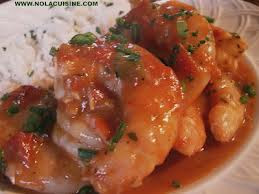The similarities between
Creole and
Cajun cuisines are due to the fact that they mutually share a French
heritage. The two cultures added new ingredients to French cooking techniques and Creole and Cajun cuisine was born. Though both types of cooking have culinary roots in France, the other major contributing cultures are Spain, Africa, and Native America. You can also add to that mix the West Indies, German, Irish, and Italian cultures but to a much lesser degree.
Both cultures take their food very seriously, and love to cook, eat, and entertain.
It is said that a Creole feeds one family with three chickens and a Cajun feeds three families with one chicken. Another major difference between Creole and Cajun food is in the type of roux used as the base of sauces, stews, soups, and other savory dishes. Creole roux is made from butter and flour (as in France), while Cajun roux is made from lard or oil and flour. This is partly due to the scarcity of dairy products in some areas of Acadiana (Acadia + Louisiana) when Cajun cuisine was being developed. Gumbo is perhaps the signature dish of both cuisines. Creole gumbo has a tomato base and is more of a soup, while Cajun gumbo has a roux base and is more of a stew. The cultural difference between the two methods of cooking lies in the fact that Creoles had access to local markets, and servants to cook their food while Cajuns lived mostly off the land, were subject to the elements of the seasons, and generally cooked meals in one large pot.
Your 1st Taste of Vermilion Pralines Is FREE-CLICK HERE
CREOLE refers to the original European — particularly French and Spanish — settlers of New Orleans. They were mostly from wealthy families and brought or sent for chefs from Madrid, Paris, and other European capitals.
Many of the ingredients the European chefs normally used in their cooking were unavailable locally. The Governor of that time, A man by the name of Bienville, in his attempt hang on to the new residents, asked his personal cheg to teach the Creole people and their chefs how to make use of the native ingredients, and to share his skills and techniques with them.
The Creoles and their cooks discovered wonderful shellfish..crab, crawfish as well as cat fish snapper, pompano, and other forms of sea and fresh water foods readily available in Louisiana. Native meats and game like dear and yes even squirrel at times, and unfamiliar produce including mirlitons and cushaw, sugar cane and pecans, were then adapted to the European cooking methods of the Creole chefs.
• Seasonings. Tips and seasoning ingredients from the native Indians, the Caribbean and African cooks helped give birth to Creole cooking. Africans introduced okra; the Spanish introduced spices and red peppers; the Germans, black pepper and mustard and the Irish, potatoes. File powder came from the Choctaw Indians; allspice and peppers from the West Indians; and garlic and tomatoes from the Italians.
Cooking Style: Creole cooking is city cooking: refined, delicate and luxurious, developed and originally prepared by servants. There is greater emphasis on cream, butter, seafood (though not shellfish), tomatoes, herbs, and garlic, and less use of cayenne pepper and file powder than in Cajun cooking, resulting in rich sauces, elegant pureed bisques, and time-intensive soups, brunch dishes, and desserts. The African influence was intensified due to the fact that the leftovers were often passed into the slave quarters where the native African women had their way with it.
Your 1st Taste of Vermilion Pralines Is FREE-Click Here
CAJUN Country is the southwest section of Louisiana, unique unto itself. Acadiana is an area comprising twenty-two parishes (counties) in Southwest Louisiana. This area is predominately populated by Cajun people who are, technically, descendents of the Acadians expelled from Acadia, now known as Nova Scotia, Canada in 1755. While their new home in Acadiana was familiar in terms of being an agrarian setting already populated by Catholic, French-speaking people, the Cajuns had to adjust to the unknown terrain of swamps, bayous, and prairies that presented some exotic forms of meat, game, fish, produce, and grains.
. Ingredients
: The Cajuns applied their French cooking techniques to these new ingredients, with a result that is recognized and respected as some of the best regional cooking in America, as well as one of the world’s most unique cuisines. There are versions of Cajun dishes on restaurant menus across the Country, from upscale to hip and trendy to fast food establishments. Unfortunately, many of these restaurants misrepresent Cajun food by using their standard menu items and carelessly over-spicing them, making the food unbearably hot, then calling it “Cajun.”
• Seasonings. Cajun food and culture has little to do with the mass media hype of the past twenty years that
presents Cajun cookery as fiery hot, and Cajun people as hot pepper eating, beer swilling caricatures of themselves. Pepper and spices are merely one element of Cajun cookery, and not the most important one at that.
Cooking Style. Cajuns in Southwest Louisiana have steadfastly adhered to the preservation of their habits, traditions, and beliefs in terms of lifestyle, language and cooking. They became noticed by society during the oil boom in the mid-1900s, which brought many outlanders (non-Cajuns) into the area. These new residents began to discover the food-oriented, talented Cajun cooks whose lives and socializing revolve, to a large extent, around the preparation, sharing, and enjoyment of food. The word began to spread.


















